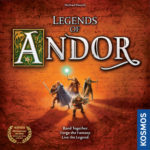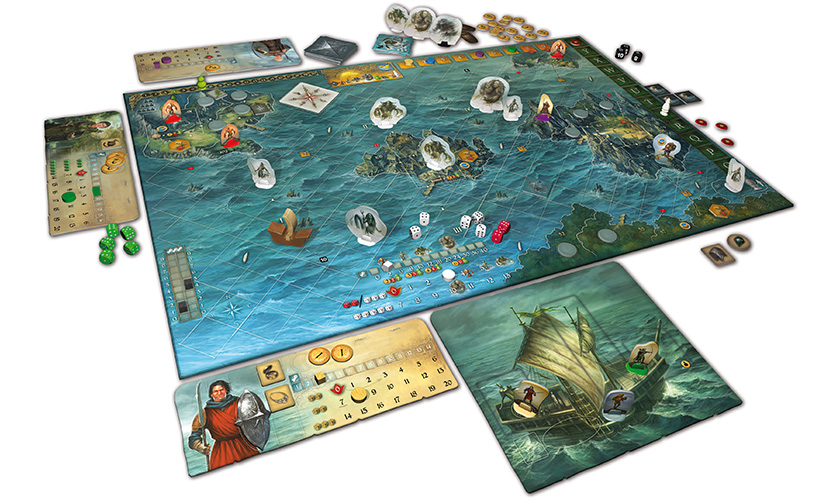Legends of Andor (Boardgame)
 Legends of Andor is a cooperative fantasy adventure boardgame, where the players combine efforts to achieve an overarching goal while simultaneously protecting the kingdom from attack. Players range the countryside combatting evil and growing in power. Fully cooperative, the players race against the game clock governed by a deck of cards that slowly ramps up the difficulty of the game until the players ultimately win or lose.
Legends of Andor is a cooperative fantasy adventure boardgame, where the players combine efforts to achieve an overarching goal while simultaneously protecting the kingdom from attack. Players range the countryside combatting evil and growing in power. Fully cooperative, the players race against the game clock governed by a deck of cards that slowly ramps up the difficulty of the game until the players ultimately win or lose.
Legends of Andor emphasizes story over mechanics so it is meant to be played over a series of five progressively more complex scenarios (entitled “Legends”.) The game allows players to “jump right in” during the first Legend as it also serves as a short tutorial to the game. Rather than read all the instructions in a rulebook, players are encouraged to read a few opening paragraphs and then start playing with additional rules added into the game as play progresses. Each scenario (Legend) is governed by a specific deck of cards which move the story forward, serve as a game timer, and in the case of the tutorial scenario, add new rules and options to the game. The scenario cards do speed up game setup and ease players into the game (in the case of the first scenario), providing explanations of new options for the players as they are needed. This also has a downside. While a master rules booklet is provided, searching for previous information (such as rules laid out on cards in previous scenarios) is not straightforward. It also means players who want to know everything before they start will be frustrated by the occasional reference to concepts which have not yet been introduced. This is mostly an issue when played with entirely new players, as any experienced player will be able to fill in the few gaps that are present until explained later in the scenario.

The basic flow of the game centers around days. Players start at daybreak and then spend time whenever they perform an action. Once they have spent their allotted time, they must rest and wait for the next day. It is possible to damage one’s self to eek out a couple of extra hours in a day but that becomes costly after repeated use. Once all characters finish their day, Sunrise occurs. A random event is revealed that will slightly modify the game for that day, monsters move about the board (based on a clever arrangement of arrows and numbers representing priority order), various bits on the board are reset and perhaps most importantly, the Legend Marker is moved up the Legend track. This track is the timer for the game and at specific spaces new scenario-specific Legend cards are revealed which can even change the goal of the scenario. Typically, the game is lost if the Legend Marker ever reaches the end of the track.
Heroes start with different combat abilities (willpower and strength) and special powers. (Side note: it is an equal-opportunity game each hero card and pawn has male and female art options.) Hero abilities include combat-oriented powers (such as rerolling or combat from a distance) and other powers that interact with the game board (discounts when buying upgrades, etc…) Both will willpower and strength are used in combat. Players roll a number of dice based on their willpower and take the highest result. This is added to their strength number and compared to the dice and strength number of an enemy. The highest total will do “damage” to the loser based on the difference of the roles. Willpower also serves as health in the game, so damaged players will be rolling fewer dice. When a monster is defeated, the winning player (or players – heroes can combine together for combats) is rewarded with gold and/or increased willpower, these can be distributed unequally if the combatants desire (for the good of the party.)
Intriguingly, whenever a monster is defeated, the Legend Marker is also moved up the track. Since defeating a monster shortens the game, players encounter the strange situation where they need to fight some monsters (most scenarios are also lost if the home castle is overrun), but not too many (or the game will end too soon in a failure.) This is one of the key components of the game that sorts players into admirers and adversaries. Since defeating monsters is not always good, the game becomes more of a puzzle than a combat heavy adventure.
Each scenario in the base game emphasizes something different. The first is primarily a tutorial with the second considered the “full game” where characters are provided new options, such as items that can purchased at set locations. The third scenario has the most variability in the setup and the endgame, but this comes at a cost links to a greater overarcing story. The fourth scenario uses the back side of the board and has the option of player elimination, giving players the option of self-sacrifice in order to progress the scenario forward. The final (fifth) scenario has the expected fight against the “big bad guy” of the story.
A few aspects of the game stand out from the crowd of adventure games (cooperative or not.) Basing most of the rules for the game (and scenarios) on the Legend cards allows for a smooth learning curve as players are introduced to new rules as they need them. (I did find the rules for “Free actions” annoying as they were available for use before they were explained on rules card.) Combat is not always a “good” thing, since it speeds up the game, giving players less time to complete their quest. The story elements of the game are strong, with art supplementing the story through lush cards, pawns, and the game board. The story is even reinforced by the Legend cards, as some Legend cards reveal new goals in the middle of a game, forcing players to adapt. This may be annoying for some and reduces the replayability of a scenario. It both annoyed me at first, but also upped the ante of the endgame as I struggled to complete the surprising new tasks set before me. I found the time-management for characters interesting as some players used up all of their time quickly while other heroes were able to take smaller-cost actions and essentially have more turns in a given day. Even the sharing mechanism is interesting, as most games have you split spoils of war evenly. Here you can choose for one player to take it all, depending on the needs of the group.

Verdict:
Those interested most in the story and puzzle-solving elements of the game will find much to like, while fans of a traditional all-out fight to the finish will feel hampered by the game’s seemingly artificial limit on defeating monsters in combat. The story-heavy nature of the scenarios limit their replayability as, with the exception of the third Legend, the scenarios always have the same starting and ending conditions. Once players have “beaten” a scenario, further replays will not add significantly different situations.
Expansions:
As with most adventure games, there are several expansions available. At present they consist of a few small additions and one new complete campaign. (*Stop by the publisher’s web site for a few free print and play bonuses for the game, including blank cards you can use to write your own Legends.)
 Legends of Andor: New Heroes
Legends of Andor: New Heroes
As one might expect, this is a pack of four new heroes available for use, each with unique powers and statistics. The expansion lets the player count go up to six players by increasing the power of monsters (and the boss) when playing with five or more. Also included is the Brother Shield item which lets characters “borrow” each other’s’ strength.
 Legends of Andor: Star Shield
Legends of Andor: Star Shield
Star Shield attempts to give the game more replayability. There is only one new Legend in the box, but enemies presented can change. The expansion provides six different end-game monsters and four different ways the Star Shield must be found. In addition, players are given one of five different tasks to be completed in the early game before the scenario is ramped up even further. As a bonus, three of the five “bosses” (the siege tower, dark temple, and catapult) are represented by a cool tokens that give a bit more urgency to their threat. The greater variety added to the game comes at a cost of the depth of story, but this is a great expansion for those who have played through the main game but want to be able to return to the game world again and again without having to relive an already played scenario.
 Legends of Andor: Journey to the North
Legends of Andor: Journey to the North
This is a big-box expansion to the game, complete with a new game board and piles of new (and more powerful) monsters. Themed as a long ocean voyage, Journey to the North scenarios focus on the journey over sea or interactions with islands on the way. This expansion also addresses two of the biggest complaints about the base game, its limited replay value and the active discouragement of monster combat. The setup in Journey to the North is more randomized, giving it more replayability, and the Legend track is no longer dependant on monster combat. Players can fight monsters (almost) all they want since defeating monsters no longer pushes the game timer forward. Of course, combats still take actions so time still marches onward each day and players can’t just simply run about fighting everything they see.






Discussion Area - Leave a Comment